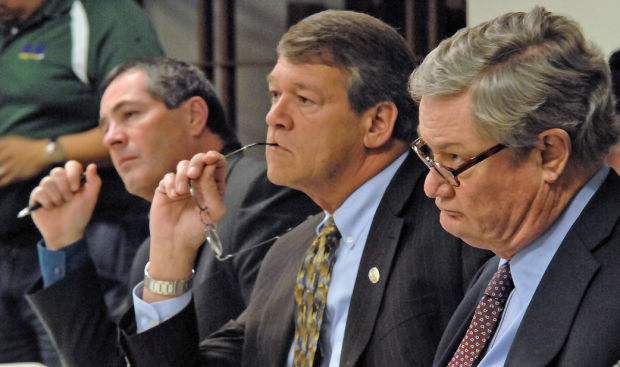Killdeer Mountains drilling sparks opposition but gets approval with conditions
The North Dakota Industrial Commission spent more than two hours Thursday listening to discussion on a proposal for drilling oil wells near the Killdeer Mountains, then voted unanimously to approve it.
The 3-0 vote came with a stipulation that Hess Corp. would have to connect the wells it drills to an oil and gas pipeline system as soon as possible to eliminate flaring of natural gas.
Lynn Helms, the state mineral resources director, outlined the drilling proposal to the commission, which also heard from a number of opponents.
Hess is proposing drilling up to eight wells on a spacing unit approximately five miles southwest of Medicine Hole, a site considered sacred to Native Americans. The site also is about three miles west of the Killdeer Mountain Battlefield Historic Site.
“The Department of Mineral Resources’ Oil and Gas Division has dedicated many hours looking at various development scenarios for well locations in order to minimize the potential impact on the landscape as well as any cultural impacts the well locations may have,” Helms said.
He told the commission that the department came up with six options for drilling at the site.
The recommended option would be to allow Hess to drill with a series of conditions.
One recommendation was for Hess to give seven days notice to the State Historical Society prior to well site construction so that an independent archaeologist could be there during that time.
Another stipulation was to only allow hydraulic fracturing between June 1 and Aug. 15 to minimize truck traffic along a rural route near the site during the school year.
The other alternatives, which were not recommended, included:
* Having surface locations to the west of the sections of land under which the oil lies, and drill west to east. Helms said that wasn’t recommended due to poor soil in one section and a rural subdivision in the other.
* Drilling from east to west. It was not recommended due to rugged topography and the nearness to the Killdeer Mountains Wildlife Management Area.
* Developing an existing spacing unit from an existing well pad. Helms said that was not recommended because it is inside a rural residential subdivision.
* Creating a 2,560-acre spacing unit and requiring Hess to drill a four-mile lateral well from south to north from the southernmost section of the spacing unit. Helms said that is not possible because the “technology simply doesn’t exist.”
* To allow no additional drilling in the spacing unit, something Helms said is not an option.
“That would leave more than 3 million barrels of oil stranded, which by statute is defined as waste,” Helms said. “Half the mineral acres in the spacing unit are private, for which the right to develop is protected by the state constitution.”
Agriculture Commissioner Doug Goehring, an Industrial Commission member, asked Helms the value of the oil if left underground. Helms estimated the 3 million barrels to be valued at approximately $250 million.
Nearby landowner Loren Jepson had said earlier that the road near the site by his home has numerous curves, low visibility and has a school bus stop.
“It’ll be traffic deluxe,” Jepson told the Industrial Commission on Thursday.
Rob Sand of the Killdeer Mountain Alliance, a group working to protect the area, urged the commission to consider waiting to allow drilling near the site. Sand said it would be better to wait for technology to advance enough so drilling could be from farther than three miles away.
He also disputed the term “waste” in describing oil being left in the ground.
“What you call waste I call storage,” Sand said.
Dakota Goodhouse, speaking as a citizen, also questioned the need to drill now. He said it took decades before drilling technology advanced enough for much of the current drilling in the state to take place.
“Why couldn’t we wait 40 years or 50 years for the technology to catch up?” Goodhouse asked.
Attorney General Wayne Stenehjem, a commission member, replied that a number of mineral rights owners are aging and probably would like to cash in at some point.
“The oil isn’t going anywhere, but they are,” Stenehjem said.
Anne Marguerite Coyle, an associate professor of biology at Jamestown College, said once the landscape is affected by development, “you can’t buy that back.”

North Dakota Industrial Commission members, from right, Governor Jack Dalrymple, Attorney General Wayne Stenehjem and Agriculture Commissioner Doug Goehring listen as Director of Mineral Resources Lynn Helms explains an oil company proposal to drill in the vicinity Killdeer Mountain at a meeting on 1-24 afternoon. The state industrial commission heard of a proposal from Loren Jepson who is request to allow drilling near his property on Killdeer Mountain as well as opposition to the drilling.

No comments:
Post a Comment